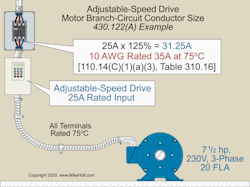Stumped by the Code? NEC Requirements for Sizing Conductors That Feed an Adjustable-Speed Drive System
Courtesy of www.MikeHolt.com
All questions and answers are based on the 2020 NEC.
Q. What is the Code definition of “electronically protected” as related to motors?
A. The NEC defines an electronically protected motor as one that is provided with electronic control, which is an integral part of the motor and protects the motor against dangerous overheating due to failure of the electronic control, overload, and failure to start [Sec. 430.2 Definitions].
This type of motor will be identified by the words “electronically protected” or “E.P.” on the nameplate, just like the motors with internal thermal protection have the words “thermally protected” on the nameplate.
A reference to this type of protection was added to Sec. 430.32(A)(2), which previously only covered thermal protection.
Q. What is the Code rule for sizing conductors that feed an adjustable-speed drive system?
A. As per Sec. 430.122(A), circuit conductors for an adjustable-speed drive system must have an ampacity of not less than 125% of the rated input current to the power conversion equipment (Fig 1).Let’s look at an example scenario to show you how this works.
What size branch-circuit conductors are required for an adjustable-speed drive system with a rated input of 25A and terminals rated 75°C (Fig. 2)?Solution: Rated input from adjustable speed drive = 25A. Branch circuit conductor = 25A × 125% = 31.25A
Use a 10 AWG conductor rated 35A at 75°C [Table 310.16 and Sec. 110.14(C)(1)(a)(3)].
Q. What is the Code rule for sizing branch-circuit short-circuit and ground-fault protection for circuits containing an adjustable-speed drive system?
A. Circuits containing an adjustable-speed drive system must be protected by a branch-circuit short-circuit and ground-fault protective device in accordance with all the following [Sec. 430.130(A)]:
(1) The rating and type of protection must be determined by Sec. 430.52(C)(1), (C)(3), (C)(5), or (C)(6), using the motor’s full‑load current (FLC) as listed in Tables 430.248 and 430.250.
Exception: The rating and type of protection is determined by Table 430.52 using the adjustable-speed drive system rated input current where the adjustable-speed drive system is listed and marked “Suitable for Output Motor Conductor Protection.”
Note No. 1: Motor conductor branch-circuit short-circuit and ground-fault protection from the adjustable-speed drive system to the motor is provided by an adjustable-speed drive system that is listed and marked “Suitable for Output Motor Conductor Protection.”
Note No. 2: A motor branch circuit using an adjustable-speed drive system, including equipment listed and marked “Suitable for Output Motor Conductor Protection,” includes the input circuit to the power conversion equipment.
(2) The maximum branch-circuit short-circuit and ground-fault protective ratings must be in accordance with the manufacturer’s instructions.
These materials are provided to us by Mike Holt Enterprises in Leesburg, Fla. To view Code training materials offered by this company, visit www.mikeholt.com/code.







